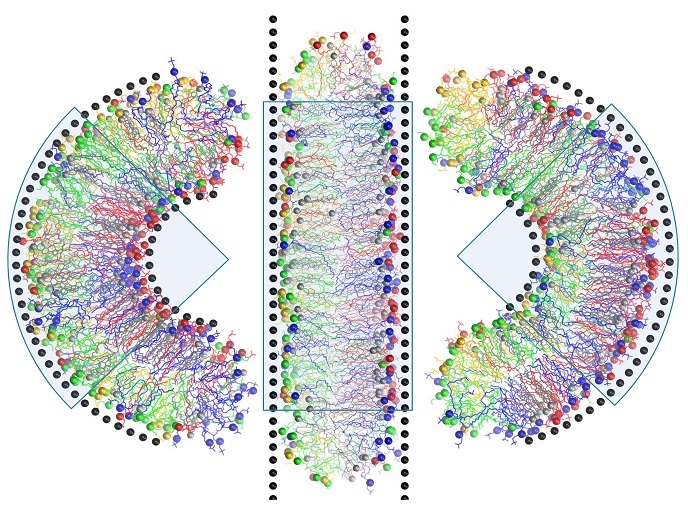When being curvy is an advantage – from a cell membrane’s perspective
Cell membranes are basically two layers of lipids, or fats. An outer leaflet contains lipids and glycolipids, both neutral, and an inner leaflet hosts practically all negatively charged lipids and phosphoinositides. This asymmetry of composition means the membranes are usually curved, and this feature is further exacerbated by the influence of membrane proteins and the cell skeleton.
Drug-membrane interactions and modelling
Of outstanding importance for pharmacology, many drugs are known to permeate, or pass through, the plasma membrane of target cells spontaneously. “Since the membranes of real cells are asymmetric in lipid composition and possess regions with very different curvature, it is important to know how these features of membranes influence the permeation of the drugs,” explains Galyna Dovbeshko, professor at the Institute of Physics of the National Academy of Sciences of Ukraine(opens in new window), coordinating institution of the assymcurv(opens in new window) project. “Up to now,” she emphasises, “it was not known which regions of the membrane are preferred for drug passage and whether such preference exists.” Moreover, the membranes of normal and malignant cells differ substantially both in terms of surface roughness and the extent of lipid asymmetry between the leaflets and this may affect uptake of anticancer drugs. “As the curvature changes in time and space, it is notoriously difficult to study experimentally,” explains Dovbeshko. Molecular dynamics simulations came to the rescue by providing an atomistic view of the membrane in a completely controllable in silico environment, using software and modelling of data to simulate the changing circumstances at the membrane. Together with these computer simulations, assymcurv researchers used a combination of experimental methods to reveal the major physical factors that influence orientation and diffusion of small molecules (drugs) as well as large integral proteins. Other technologies used in a complementary way to the computer simulations included ‘wet’ biochemistry (classical analytical chemistry) and molecular biology as well as enhanced infrared and Raman spectroscopy. “Project results demonstrate remarkable versatility and plasticity of lipid-protein interactions and suggest that lipids and membrane proteins can be intimately adapted and re-adapted to each other in the test tube,” reports Dovbeshko. “This, despite the drastic changes in both lipid composition and protein structure,” she adds.
Resistance to anticancer drugs tackled at the membrane level
Marie Skłodowska-Curie fellows Semen Yesylevskyy and Christophe Ramseyer, professor at project partner University of Franche-Comté, studied another aspect of the membrane’s sphere of influence of its curvature. This covered permeability for ions, water, and the anticancer drugs cisplatin and gemcitabine, which is involved in development of resistance to these widespread anticancer drugs. The results showed overwhelmingly, for the first time, that permeability of the asymmetric lipid membrane strongly depends on the curvature(opens in new window). A highly curved membrane is one to three orders of magnitude more permeable for water, ions, cisplatin and gemcitabine in comparison to a flat one. “Our results therefore show that high membrane curvature should not be neglected during the evaluation of membrane permeability for hydrophilic drugs,” Yesylevskyy states in their recently published paper(opens in new window). The assymcurv project’s results open up a whole new field of research that may eventually elucidate the physiological role of membrane curvature and lipid asymmetry modulation in bacterial and cancer cells. This could reveal the mechanisms of drug uptake and resistance, the researchers emphasise.







